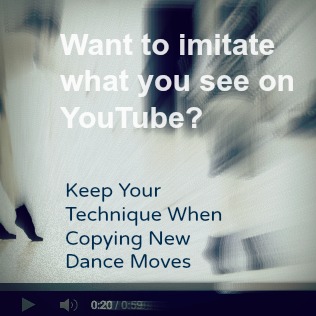Have you ever been tempted to try out some of the choreography from So You Think You Can Dance? What about a new step you saw on Youtube? You should.
 The only problem with tackling something from Youtube, or another video source, is you are learning by sight (as opposed to being teacher-guided through movements) and increase your risk for injury. Many times we as dancers focus on completing the movement, but we don’t always remember to apply the principles of proper technique, and without proper technique… well, your dancing career will be short.
The only problem with tackling something from Youtube, or another video source, is you are learning by sight (as opposed to being teacher-guided through movements) and increase your risk for injury. Many times we as dancers focus on completing the movement, but we don’t always remember to apply the principles of proper technique, and without proper technique… well, your dancing career will be short.
Sustainability comes through applied technique.
I recommend a simple process for tackling new dance steps. First, break the puzzle into pieces, then apply the proper technique, last, put the puzzle back together.
Breaking the Choreography Puzzle into Pieces
Watch the video a few times and become familiar with the general idea of the step. Are we jumping? Rolling? Turning? All of the above?
After you have the general idea, break it down further into recognizable pieces. Find the sautés, rond de jambes, retirés etc. The pieces may not look like something straight out of a technique class, but you’ll be able to find similarities. The rond de jambe might be turned in, or the sauté might end in a roll to the floor.
Now mark it a couple of times to get the general feel into your body.
Apply Good Dance Technique
Once you have a sequence of recognizable pieces go “back to class.” You know what a good rond de jambe looks and feels like, and you know that in executing one you should be supporting with your abdominal wall, lifting up out of the supporting leg, pointing your foot and lengthening through the knee.
Apply your class knowledge to all of the pieces in this manner. Correct each piece as you come to it. It’s a great idea to get your iPhone out and record yourself, at the very least have a friend with a critical eye watch you. Are you doing anything that will hurt your body? Double check your alignment and core support.
Anytime we try something new, we contact muscles in new sequences. You need to make sure that you aren’t hurting yourself or building bad habits in your body early in the learning process, before you have done it fifty times and demonstrated for all of your BFF’s at school.
Put it all Together
Once that you have a set of beautiful, technically sound pieces, put them back together. If the sequence is not perfect right away, that’s ok. Better to work on a step or phrase of choreography for a few weeks and be able to execute it safely and beautifully, than force your body to stumble through it right away and sprain your ankle in the process.
There is no shame in putting time and effort into new choreography. It shows dedication. You might get the first movements together and spend a week or two working through the middle of the sequence, then you can do the whole thing.
We live in a wonderful world where everyone has video capabilities in their pocket. We can share new choreography with the world instantly, perpetuating both our art and our creative process in a way that is light years beyond anything our ancestors could have done.
Methods of recording movement were almost non-existent until moving pictures entered the scene in the late 1880’s, so choreography had to be passed on directly from master to student.
While easier, faster sharing allows our generation to keep dance alive and thriving, keep in mind, not everyone on Youtube is perfect; shocking I know.
If you see someone executing a really cool step without sound technique, don’t go “jumping off that bridge.” You know better.
He or she might be getting through the sequence, but they’re going to injure themselves eventually. Let’s not do that.
Sustainability comes through applied technique.
Laurel Foley has been dancing for over 20 years, she earned her BA in Dance Pedagogy from Butler University. She currently teaches ballet and children’s dance at Style Dance Academy in Franklin, IN and is enrolled in the BASI Pilates teacher training program

Dance Advantage welcomes guest posts from other dance teachers, students, parents, professionals, or those knowledgeable in related fields. If you are interested in having your article published at Dance Advantage, please see the following info on submitting a guest post. Read posts from guest contributors.

